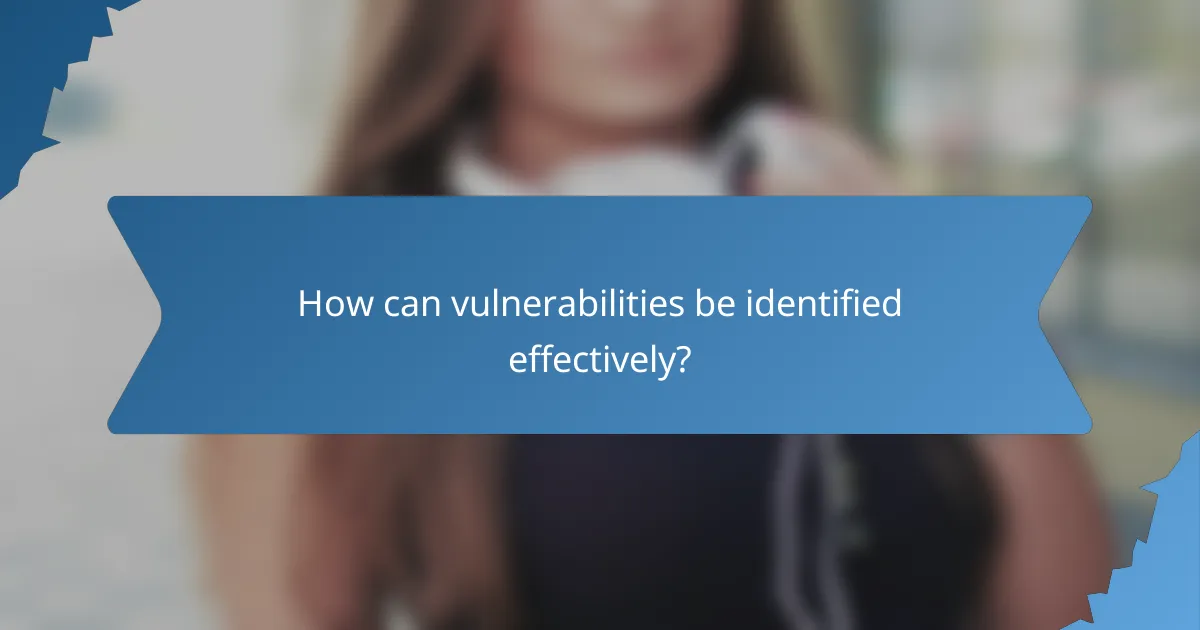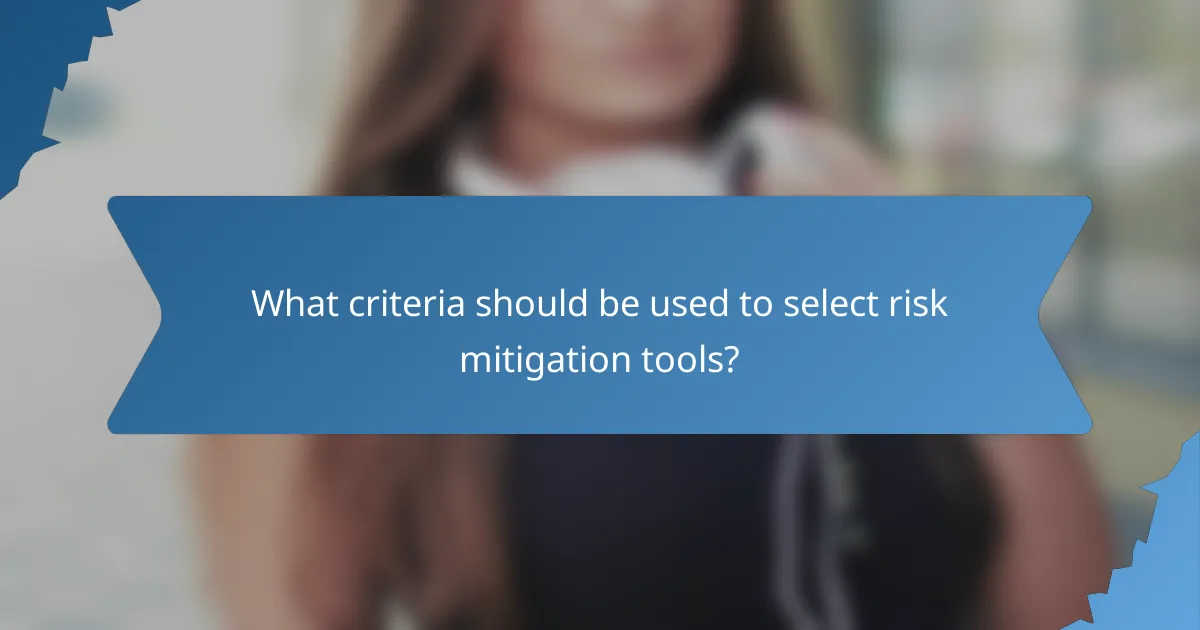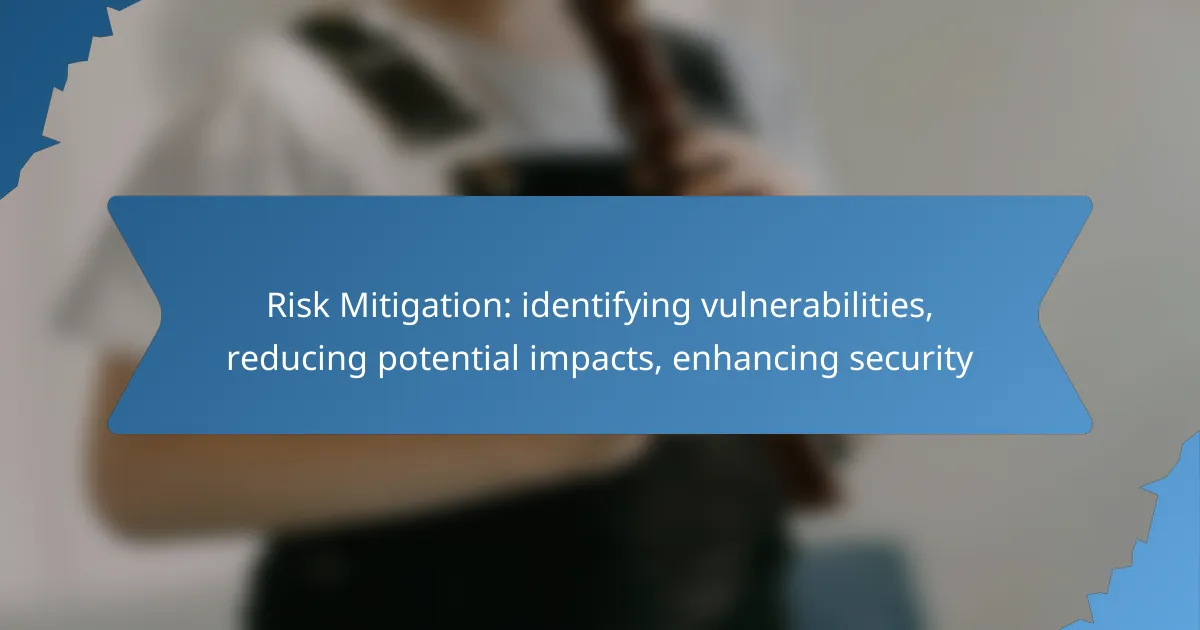Effective risk mitigation involves a proactive approach to identifying vulnerabilities, reducing potential impacts, and enhancing security measures. By employing comprehensive strategies that include audits, training, and response plans, organizations can better protect their assets and minimize the consequences of security breaches.

What are the best practices for risk mitigation in Canada?
Effective risk mitigation in Canada involves identifying vulnerabilities, reducing potential impacts, and enhancing security measures. Organizations should adopt a comprehensive approach that includes frameworks, audits, training, tools, and response plans to safeguard their assets.
Implementing a risk assessment framework
Establishing a risk assessment framework is crucial for identifying potential vulnerabilities within an organization. This framework should include regular evaluations of assets, threats, and vulnerabilities, allowing organizations to prioritize risks based on their potential impact.
Common frameworks used in Canada include ISO 31000 and NIST SP 800-30, which provide structured methodologies for assessing risks. Organizations should customize these frameworks to fit their specific operational context and regulatory requirements.
Conducting regular security audits
Regular security audits help organizations evaluate the effectiveness of their current security measures. These audits should assess both physical and digital security controls, identifying gaps that could be exploited by threats.
It is advisable to conduct audits at least annually, or more frequently if significant changes occur within the organization. Engaging third-party auditors can provide an objective perspective and help uncover overlooked vulnerabilities.
Training employees on security protocols
Employee training is a vital component of risk mitigation, as human error is often a leading cause of security breaches. Organizations should implement ongoing training programs that cover security protocols, phishing awareness, and incident reporting procedures.
Training sessions should be interactive and tailored to different roles within the organization, ensuring that all employees understand their responsibilities in maintaining security. Regular refresher courses can help reinforce these concepts and keep security top of mind.
Utilizing cybersecurity tools
Investing in cybersecurity tools is essential for protecting against various threats. Organizations should consider implementing firewalls, intrusion detection systems, and antivirus software to create a multi-layered defense strategy.
In Canada, businesses can benefit from tools that comply with local regulations, such as the Personal Information Protection and Electronic Documents Act (PIPEDA). Regular updates and patches for these tools are critical to ensure they remain effective against evolving threats.
Establishing incident response plans
Having a well-defined incident response plan is crucial for minimizing the impact of security breaches. This plan should outline the steps to take when a security incident occurs, including roles and responsibilities, communication protocols, and recovery strategies.
Organizations should regularly test their incident response plans through simulations and tabletop exercises. This practice ensures that employees are familiar with the procedures and can respond effectively under pressure, ultimately reducing recovery time and costs associated with incidents.

How can vulnerabilities be identified effectively?
Vulnerabilities can be identified effectively through systematic approaches that include technology and human expertise. Utilizing tools and techniques such as vulnerability scanning software, penetration testing, and analyzing security logs can help uncover weaknesses in systems and processes.
Using vulnerability scanning software
Vulnerability scanning software automates the process of identifying security weaknesses in systems, networks, and applications. These tools scan for known vulnerabilities, misconfigurations, and compliance issues, providing a comprehensive overview of potential risks.
When selecting a vulnerability scanner, consider factors such as ease of use, integration capabilities, and the frequency of updates to the vulnerability database. Popular options include Nessus, Qualys, and OpenVAS, each offering different features to suit various organizational needs.
Conducting penetration testing
Penetration testing involves simulating cyberattacks to evaluate the security of a system. This proactive approach helps identify vulnerabilities that may not be detected by automated tools, as it mimics the tactics of real-world attackers.
Engaging skilled penetration testers can provide insights into how vulnerabilities can be exploited and the potential impact on the organization. It is advisable to conduct penetration tests regularly, especially after significant changes to systems or applications, to ensure ongoing security.
Analyzing security logs
Analyzing security logs is a crucial method for identifying vulnerabilities and understanding security incidents. Logs from firewalls, intrusion detection systems, and application servers can reveal patterns of suspicious activity or attempts to exploit weaknesses.
Establish a routine for reviewing logs, focusing on anomalies such as repeated failed login attempts or unusual access patterns. Implementing a centralized logging solution can streamline this process, making it easier to correlate events and identify potential vulnerabilities across the organization.

What are the potential impacts of security breaches?
Security breaches can lead to significant consequences for organizations, affecting their finances, reputation, and legal standing. Understanding these impacts is crucial for effective risk mitigation and enhancing overall security.
Financial losses
Financial losses from security breaches can vary widely, often reaching into the millions for larger organizations. Costs may arise from direct theft, recovery efforts, and increased insurance premiums, alongside potential fines from regulatory bodies.
For example, a data breach might require extensive forensic investigations and system upgrades, which can add up quickly. Organizations should budget for potential losses and consider investing in cybersecurity insurance to mitigate financial risks.
Reputation damage
Reputation damage is a critical impact of security breaches, as it can erode customer trust and loyalty. Once a breach becomes public knowledge, customers may hesitate to engage with a company, leading to decreased sales and long-term brand harm.
To counteract reputation damage, organizations should have a crisis communication plan in place. Promptly addressing the breach, being transparent about its impact, and outlining steps taken to prevent future incidents can help rebuild trust.
Legal consequences
Legal consequences can arise from security breaches, particularly if sensitive customer data is compromised. Organizations may face lawsuits, regulatory fines, and compliance issues, especially under laws like GDPR or CCPA that impose strict data protection requirements.
To minimize legal risks, companies should ensure compliance with relevant regulations and maintain robust data protection practices. Regular audits and employee training can help identify vulnerabilities and prevent breaches that could lead to legal action.

How to enhance security measures?
Enhancing security measures involves implementing strategies that protect systems from vulnerabilities and reduce potential impacts. Key actions include adopting multi-factor authentication, implementing encryption protocols, and regularly updating software to stay ahead of threats.
Adopting multi-factor authentication
Multi-factor authentication (MFA) adds an extra layer of security by requiring users to provide two or more verification factors to gain access. This might include something they know (like a password), something they have (like a smartphone), or something they are (like a fingerprint).
Implementing MFA significantly reduces the risk of unauthorized access, as it requires multiple forms of validation. For example, a banking app may send a text message with a code that users must enter in addition to their password.
Implementing encryption protocols
Encryption protocols protect sensitive data by converting it into a coded format that can only be read by authorized parties. Common protocols include SSL/TLS for web traffic and AES for data at rest.
Using encryption is crucial for safeguarding personal information, especially in industries like finance and healthcare. For instance, encrypting emails ensures that only the intended recipient can read the content, reducing the risk of data breaches.
Regularly updating software
Regular software updates are essential for maintaining security, as they often include patches for known vulnerabilities. Failing to update can leave systems exposed to attacks that exploit these weaknesses.
Establish a routine for checking and applying updates, ideally automating the process where possible. This includes operating systems, applications, and security software to ensure comprehensive protection against emerging threats.

What criteria should be used to select risk mitigation tools?
Selecting risk mitigation tools involves evaluating their effectiveness, cost, and ease of implementation. Key criteria include the tool’s ability to identify vulnerabilities, reduce potential impacts, and enhance overall security.
Effectiveness in Vulnerability Identification
The primary criterion for selecting risk mitigation tools is their effectiveness in identifying vulnerabilities. Tools should provide comprehensive assessments that highlight potential risks across various systems and processes. Look for solutions that utilize advanced technologies like machine learning or threat intelligence to enhance detection capabilities.
For example, vulnerability scanning tools can help organizations pinpoint weaknesses in their networks or applications. It’s essential to choose tools that not only identify existing vulnerabilities but also offer actionable insights for remediation.
Cost-Effectiveness
Cost-effectiveness is crucial when selecting risk mitigation tools. Organizations should assess both the initial investment and ongoing operational costs. A tool may have a low purchase price but could incur high maintenance or subscription fees over time.
Consider tools that offer tiered pricing models, allowing you to scale usage based on your organization’s size and needs. Additionally, factor in potential cost savings from reduced incidents or breaches when evaluating overall value.
Ease of Implementation
Ease of implementation is another critical factor in selecting risk mitigation tools. Tools should integrate seamlessly with existing systems and require minimal disruption during deployment. Look for solutions that offer user-friendly interfaces and comprehensive support resources.
For instance, cloud-based tools often provide quicker setup times and easier updates compared to on-premises solutions. Ensure that your team has the necessary skills to operate the tool effectively, or consider options that include training and support services.
Regulatory Compliance
Regulatory compliance is essential when choosing risk mitigation tools, especially in industries like finance or healthcare. Tools should help organizations meet relevant standards such as GDPR, HIPAA, or PCI-DSS. This ensures that your risk management efforts align with legal requirements and avoid potential penalties.
Evaluate whether the tool provides features that facilitate compliance reporting and documentation. Tools that automate compliance checks can save time and reduce the risk of human error.
